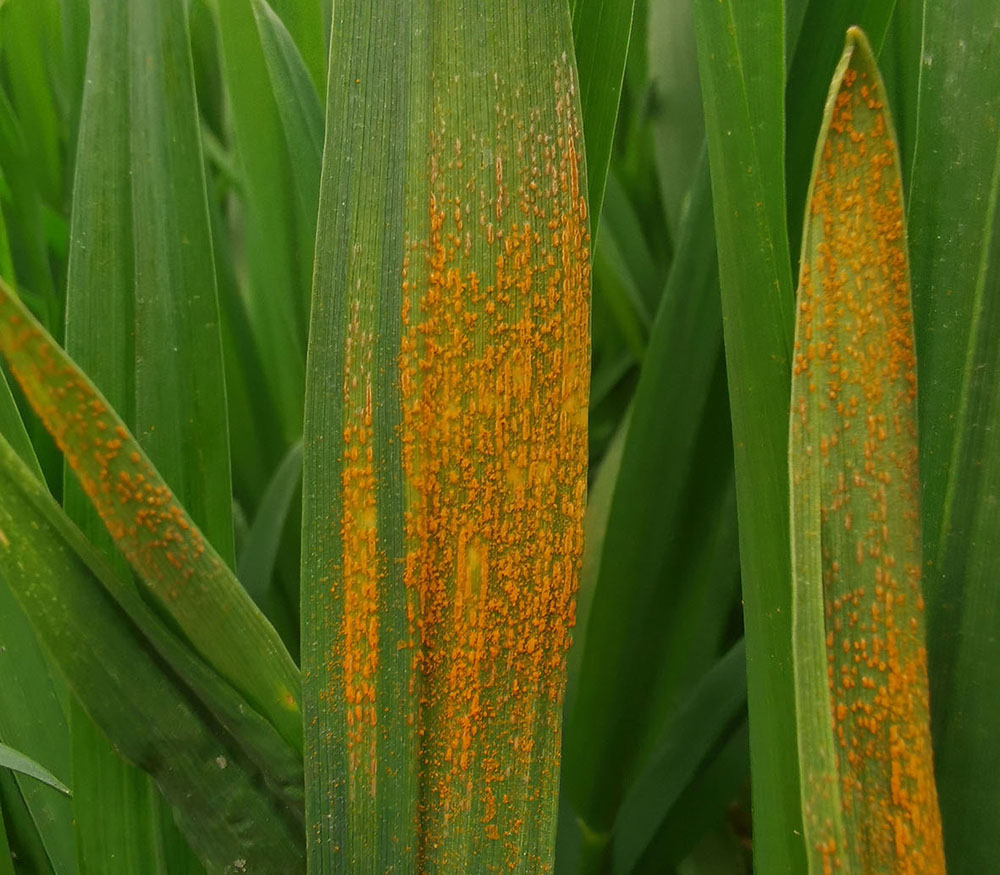

Breaking the Gene Code Conferring Broad-spectrum Resistance to Rust Fugi
Received date: 2022-07-03
Revised date: 2022-07-08
Online published: 2022-07-14
Wheat stripe rust, also known as yellow rust, is a disease caused by the fungus Puccinia striiformis f. sp. tritici (Pst) that can devastate wheat crops across the world. The most effective way to control rust diseases is by planting and breeding durable resistant wheat cultivars. The caveat of R gene-dependent disease resistance is the frequent loss of effectiveness due to pathogen mutations that allow evasion of detection by immune receptors. However, disruption of host baseline susceptibility by inactivating S genes could be adopted for broad-spectrum and durable disease resistance. A recent study finished by the research team at Northwest A&F University significantly advanced our understanding how wheat plants can be protected by a S gene and provided tools in the fight against a major disease. Upon infection, the fungus induces a receptor-like cytoplasmic kinase, TaPsIPK1, specifically interacting with the effector, PsSpg1, that promotes parasitism via enhancing kinase activity and nuclear entry of TaPsIPK1. TaPsIPK1 phosphorylates the transcription factor TaCBF1d for gene regulation. Phosphorylation of TaCBF1d switches its transcriptional activity on the downstream genes. Hence the enhanced TaCBF1d phosphorylation by TaPsIPK1 and PsSpg1 might reprogram target gene expression to disturb plant defense response and thus facilitate pathogen infection. CRISPR-Cas9 inactivation of TaPsIPK1 in wheat confers broad-spectrum resistance against Pst without impacting important agronomic traits in two-years of field tests. This is first study to reveal a new phosphorylation-transcriptional regulation mechanism triggered by PsSpg1-TaPsIPK1-TaCBF1d in wheat S genes to stripe rust, which provide a new strategy to develop cultivars with durable resistance by genetic modifications in crops.

Kong Lingrang . Breaking the Gene Code Conferring Broad-spectrum Resistance to Rust Fugi[J]. Chinese Bulletin of Botany, 2022 , 57(4) : 405 -408 . DOI: 10.11983/CBB22142
| [1] | 邓一文, 刘裕强, 王静, 陈学伟, 何祖华 (2021). 农作物抗病虫研究的战略思考. 中国科学: 生命科学 51, 1435-1446. |
| [2] | 韩德俊, 康振生 (2018). 中国小麦品种抗条锈病现状及存在的问题与对策. 植物保护 44(5), 1-12. |
| [3] | 李振岐, 曾士迈 (2002). 中国小麦锈病. 北京: 中国农业出版社. pp. 34-36. |
| [4] | 马占鸿 (2018). 中国小麦条锈病研究与防控. 植物保护学报 45, 1-6. |
| [5] | 张杰, 董莎萌, 王伟, 赵建华, 陈学伟, 郭惠珊, 何光存, 何祖华, 康振生, 李毅, 彭友良, 王国梁, 周雪平, 王源超, 周俭民 (2019). 植物免疫研究与抗病虫绿色防控: 进展、机遇与挑战. 中国科学: 生命科学 49, 1479-1507. |
| [6] | Deng YW, Ning YS, Yang DL, Zhai KR, Wang GL, He ZH (2020). Molecular basis of disease resistance and perspectives on breeding strategies for resistance improvement in crops. Mol Plant 13, 1402-1419. |
| [7] | Li SN, Lin DX, Zhang YW, Deng M, Chen YX, Lv B, Li BS, Lei Y, Wang YP, Zhao L, Liang YT, Liu JX, Chen KL, Liu ZY, Xiao J, Qiu JL, Gao CX (2022). Genome-edited powdery mildew resistance in wheat without growth penalties. Nature 602, 455-460. |
| [8] | Li W, Deng YW, Ning YS, He ZH, Wang GL (2020). Exploiting broad-spectrum disease resistance in crops: from molecular dissection to breeding. Annu Rev Plant Biol 71, 575-603. |
| [9] | Lin ZJD, Liebrand TWH, Yadeta KA, Coaker G (2015). PBL13 is a serine/threonine protein kinase that negatively regulates Arabidopsis immune responses. Plant Physiol 169, 2950-2962. |
| [10] | Ma JB, Huang XL, Wang XJ, Chen XM, Qu ZP, Huang LL, Kang ZS (2009). Identification of expressed genes during compatible interaction between stripe rust (Puccinia striiformis) and wheat using a cDNA library. BMC Genomics 10, 586. |
| [11] | Wang N, Fan X, He MY, Hu ZY, Tang CL, Zhang S, Lin DX, Gan PF, Wang JF, Huang XL, Gao CX, Kang ZS, Wang XJ (2022a). Transcriptional repression of TaNOX10 by TaWRKY19 compromises ROS generation and enhances wheat susceptibility to stripe rust. Plant Cell 34, 1784-1803. |
| [12] | Wang N, Tang CL, Fan X, He MY, Gan PF, Zhang S, Hu ZY, Wang XD, Yan T, Shu WX, Yu LG, Zhao JR, He JN, Li LL, Wang JF, Huang XL, Huang LL, Zhou JM, Kang ZS, Wang XJ (2022b). Inactivation of a wheat protein kinase gene confers broad-spectrum resistance to rust fungi. Cell https://doi.org/10.1016/j.cell.2022.06.027. |
| [13] | Wang YP, Cheng X, Shan QW, Zhang Y, Liu JX, Gao CX, Qiu JL (2014). Simultaneous editing of three homoeoalleles in hexaploid bread wheat confers heritable resistance to powdery mildew. Nat Biotechnol 32, 947-951. |
| [14] | Wellings CR (2011). Global status of stripe rust: a review of historical and current threats. Euphytica 179, 129-141. |
| [15] | Zaidi SSEA, Mukhtar MS, Mansoor S (2018). Genome editing: targeting susceptibility genes for plant disease resistance. Trends Biotechnol 36, 898-906. |
/
| 〈 |
|
〉 |